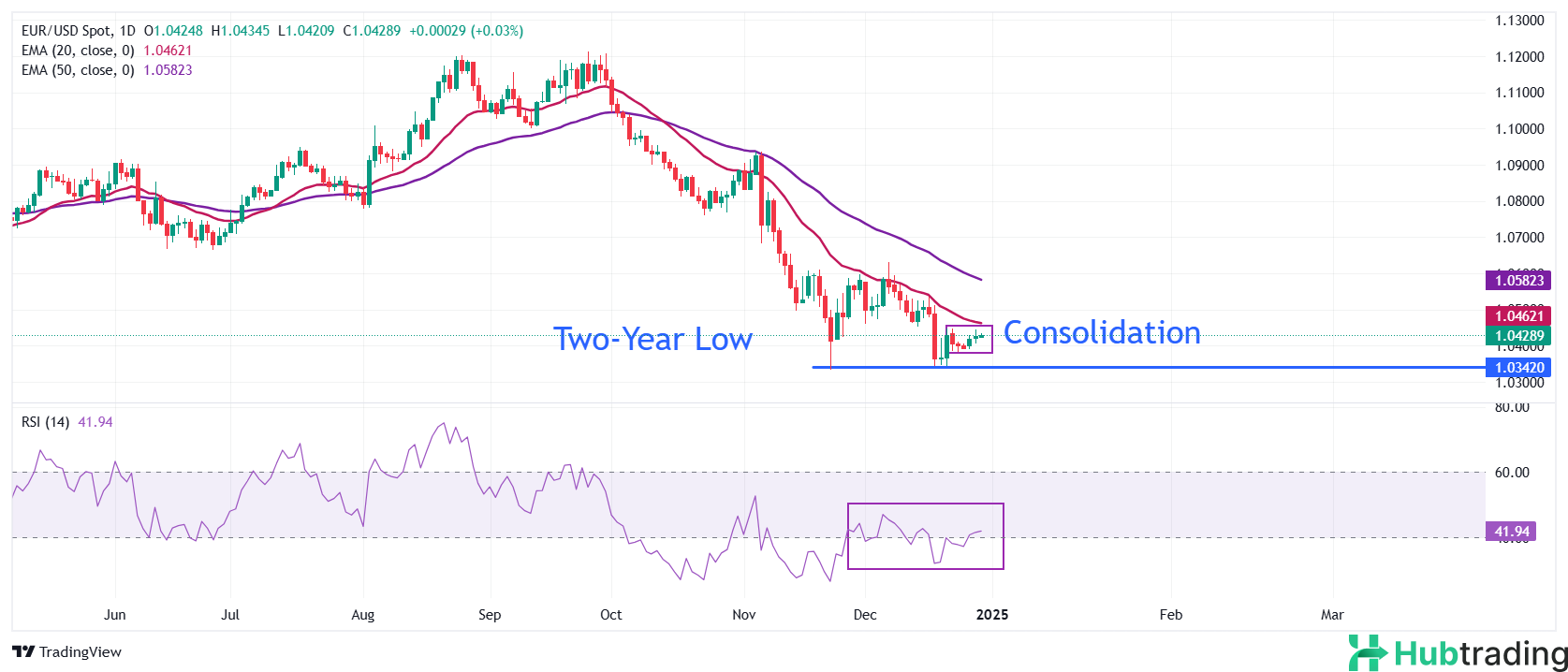- EUR/USD climbs to a new weekly high near 1.0450 amid thin trading volumes.
- The Euro is on track to close the year with a 5.5% loss against the US Dollar, weighed down by the ECB’s dovish stance and potential US-EU trade tensions.
- US investors are set to focus on the December ISM Manufacturing PMI data this week.
EUR/USD surged to around 1.0450 during Monday’s New York session, buoyed by stronger-than-expected inflation data from Spain. The preliminary Harmonized Index of Consumer Prices (HICP) for December showed a year-over-year increase of 2.8%, exceeding the forecast of 2.6% and the previous release of 2.4%. On a monthly basis, HICP rose by 0.4%, outpacing expectations of 0.3%, while core inflation remained flat in November.
Despite the recent gains, EUR/USD is poised to end 2024 with a 5.5% annual loss, largely driven by the European Central Bank’s (ECB) dovish stance on interest rates and concerns over potential economic disruption from US tariff hikes under President-elect Donald Trump.
This year, the ECB reduced its Deposit Facility Rate by 100 basis points to 3% and signaled plans to lower it further to 2% by mid-2025, with 25 basis point cuts expected at each meeting in the first half of next year. Policymakers remain concerned about inflation undershooting the 2% target, compounded by political uncertainty in Germany and the potential for a US-EU trade war.
ECB President Christine Lagarde recently cautioned against retaliatory trade measures, arguing in a Financial Times interview that such actions harm the global economy. In contrast, Finnish central bank Governor Olli Rehn advocated for a tougher stance, suggesting the EU should prepare countermeasures to strengthen its negotiating position if faced with higher US tariffs.
Daily Market Movers: EUR/USD Gains as US Dollar Weakens
- EUR/USD climbs in thin trading conditions ahead of the New Year, benefiting from a softer US Dollar (USD). The US Dollar Index (DXY), which measures the Greenback against six major currencies, dips to around 107.80 but remains on track to close the year near its highest level.
- Rising US Treasury yields have supported the USD in recent months, driven by expectations that President-elect Trump’s policies of higher tariffs and lower taxes will boost economic growth and inflation. This outlook could push the Federal Reserve (Fed) toward a more hawkish monetary stance.
- In its latest dot plot, the Fed signaled fewer interest rate cuts for 2025, projecting the Federal Funds rate to reach 3.9% by year-end. Following December’s hawkish rate cut, Goldman Sachs forecasts the next cut in March, with additional cuts in June and September.
- This week, markets will closely watch the US ISM Manufacturing PMI data for December, due Friday. The index is expected to slightly decline to 48.3 from 48.4, indicating a continued contraction in manufacturing output.
Technical Analysis: EUR/USD Holds Key Support at 1.0400

EUR/USD remains range-bound above the two-year low of 1.0335, consolidating since Monday. The pair’s outlook stays bearish, with the 20-day and 50-day Exponential Moving Averages (EMAs) trending lower at 1.0464 and 1.0588, respectively.
The 14-day Relative Strength Index (RSI) hovers near 40.00, and sustained movement below this level could signal further downside momentum.
If the pair breaks below the two-year low of 1.0330, it could decline toward the psychological support at 1.0200. On the upside, the 20-day EMA near 1.0500 serves as a key resistance level for Euro bulls attempting a recovery.





